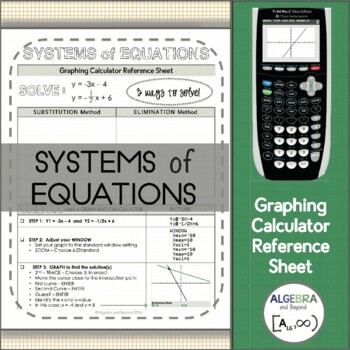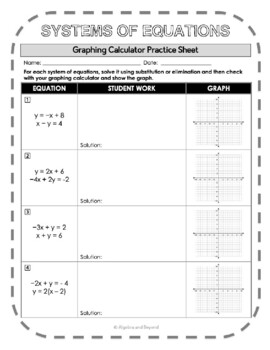Graphing Systems of Equations | TI-84 Calculator Reference Sheet and Practice
- PDF
- Google Apps™
- Easel Activity

What educators are saying
Also included in
- Are your students struggling to grasp the concepts of solving systems of equations by graphing, substitution, and elimination? Do you want to make the learning process more enjoyable while ensuring effective comprehension? Look no further than this Systems of Equations Mini-Bundle where students usePrice $10.50Original Price $17.75Save $7.25
- Build your students’ understanding of the TI-84 graphing calculator without repeating yourself over and over again - these graphing calculator reference sheets are step-by-step guides on how to use the TI-84 calculator for 40 different math topics in Algebra 1, Algebra 2, and Precalculus! Add thesePrice $45.00Original Price $75.00Save $30.00
Description
This graphing calculator reference sheet guides students step-by-step on how to check their system of equations solution on the calculator.
INCLUDED:
- Reference Sheet: A reference page with step-by-step instructions
- Practice Sheet: A practice page with four problems for students to review what they've learned.
- Digital Version: A Google Jamboard version is also included so students can practice these skills digitally.
Teaching graphing calculator skills help students with:
• Speed
• Making connections
• Checking for accuracy
• Leaping hurdles
*Reference sheet can be used with a TI-83 or TI-84 graphing calculator.
Please look at the preview to find out more information about this resource.
Check out more graphing calculator sheets here or get all of them...Graphing Calculator Reference Sheet - GROWING BUNDLE
∞∞∞∞∞∞∞∞∞∞∞∞∞∞∞∞∞∞∞∞∞∞∞∞∞∞∞∞∞∞∞∞∞∞∞∞∞∞∞∞∞∞∞∞∞∞∞
Learn more about Algebra and Beyond's resources:
• Website
© Algebra and Beyond 2016
This product is intended for personal use in one classroom only. For use in multiple classrooms, please purchase additional licenses.







